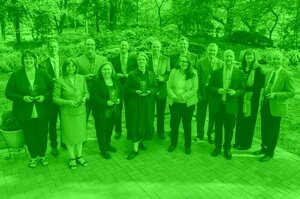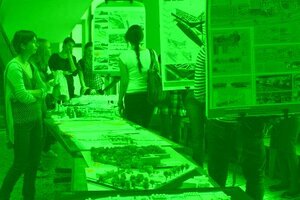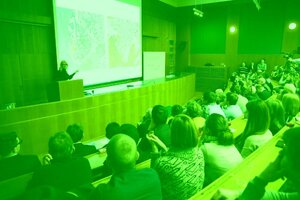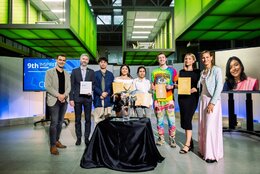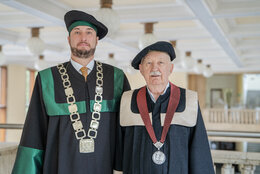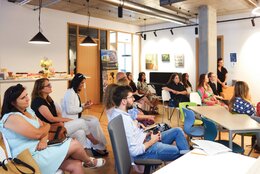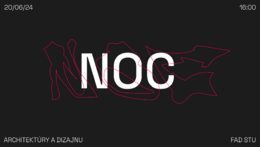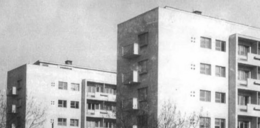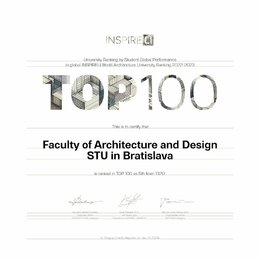The Institute of Ecological and Experimental Architecture (IEEA) comprises a variety of sciences dealing with environmental quality. Its scope is the environment defined by the geographical conditions, culture, history, etc. The complexity of the environment and its manifold understanding have been a part of research and educational applications since its establishment (More about the IEEA history and its scope). They enhance creative activities that are based on the protection of the environment, sustainability and cultural heritage perspectives. IEEA teaching programs at the Faculty of Architecture and Design, are integral parts of accredited study programmes in all degree levels – Bachelor, Master and PhD.
Head of the Institute:
Ing. arch. Tibor Varga, PhD. ✉
Deputy Head of the Institute:
assoc. prof. Ing. arch. Ján Legény, PhD. ✉
Secretary:
Milada Kovácsová ✉
Address:
Institute of Ecological and Experimental Architecture
Faculty of Architecture and Design STU
Námestie slobody 19
812 45 Bratislava
Slovakia
Vertical Design Studios at the IEEA
- A:ZA_Green Architecture Design Studio (Supervisors: H. Pifko; K. Macháčová; L. Krajcsovics)
- Data[LAB] (Supervisors: M. Uhrík; R. Hajtmanek et al.)
- Wooden Design Studio (Supervisors: T. Varga; L. Šíp)
- Legény & Morgenstein Design Studio (Supervisors: J. Legény; P. Morgenstein; R. Špaček)
History and scope of the Institute of Ecological and Experimental Architecture
(written by J. Keppl & R. Špaček)
Architecture has always been related to the environment whether in the sense of a built environment for its users or as a part of a wider whole. Architecture makes the environment and at the same time, it is created by the environment. Initially, architecture was a response to natural stimuli, especially winds. It was also shaped by the sun, rain, snow, etc. Civilization achievements, scientific discoveries, and technical inventions enabled the builders to break the connection between the shelter, dwelling or cult structures and their natural environment and become independent. Nevertheless, we have concluded recently that we pay an enormously high price for the escape to our world. As a result, we try, by all means, to return to the original harmony and co-living with our mother Earth.
The light motive is that it does not do that our architecture functions well and is beautiful. We also want it to friendly co-exist with the environment. Based on Immanuel Kant's categorical imperative we push architecture into the role of environmental ethic. We aim for a paraphrase of the slogan of the 17th biennial of Architecture in Venice (2000): "More ethics less aesthetics" restated as "More ethics, (not inevitably) less aesthetics".
Methodological activities of the Institute of Ecological and Experimental Architecture have brought about numerous notable results. First, it was the enviousness of other institutes for not having such high interest of students, who preferred the institute in the second degree of study. Later, the eco- and enviro- principles started to be preferred by practically all students. In fact, this is the main point of our endeavour.
The Institute (originally Department of Experimental and Ecologically Determined Design) was established thanks to the initiative and foresight of the teachers, who for a long time before 1989 had studied and paid attention to issues of architecture and environment, architecture and limited resources, namely the energy resources, non-traditional energy resources and materials. This was the basis for a team, which could form a meaningful training programme and prepare research projects orientated to architecture and ecology relations. The beginnings of the Institute's teaching can be characterized as an experiment for the students of the 5th and 6th year of the study. This experiment meant the preparation for the establishment of the two-degree study at the Faculty of Architecture and thanks to this programme the Institute was ready to prepare a specialization with theoretical subjects.
At that time, the Institute started to work in conditions that are considered standard at foreign universities but are difficult to push forward in our academic environment. Its existence was bound to the interest of students.
The Institute aims at architecture as an integral part of the unchanged, natural and changed, built environment. This access to architecture conditions its connection with scientific disciplines, which cover the issues of the environment. Ecology as the science covering the relations between living organisms and their environment has a dominant position among the environmental disciplines. It provides a way how to reshape the environment without a serious interruption to its stability on one side, and on the other, it is an inspiration for searching for new expressions in architecture.
The Master's Degree is oriented on the following topics:
- the basis for ecologically determined design and environmental nature of architecture
- material and style links between architecture and environment (regional architecture)
- practical experience and methods of ecologically determined design (solar energy, alternative energy resources, etc...)
- alternative building materials and technologies,
- search for boundary settings for the urban-architectural concepts, limited by an existing built area
- conditions for sustainable development of urban settlements and issues of urban democracy.
The study programmes of the integrated studio are aimed at architectural design determined by physical factors of the environment (sun, wind, precipitation), harmonizing the designed architectural work with natural and cultural complex of the environment, design of the economic structures using the renewable energy resources and biocompatible building materials, search for alternative forms of residential environment and alternatives for traditional ways of living.
Cooperation, integration, complexity and interdisciplinarity are basic principles in the field of protection and creation of environment namely of the human environment. They are, therefore taking part in the process of decision and selection of education methods, and the content of environmental education. An architect, urban planner or product designer must be a good manager and coordinator of cooperation between different natural science, technical science and artistic professional specialists. To master these tasks, he/she has to be well theoretically and practically prepared. Such cooperation is therefore important as part of each studio tutorial, seminar or practical exercise. The classes are tutored by different field specialists, not only the university teachers but teachers from other universities as well as from foreign workplaces. Such cooperation will remain the core of future Faculty education activities. We aim to make the study programme more compact within its social-ecological and natural-ecological dimensions. In the offered study programmes we would like to go beyond the so far existing framework of the Faculty.
Back to the Home page of the Institute >>>





